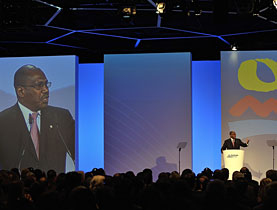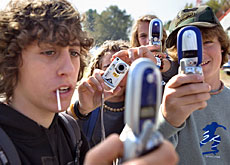Smartphones take hold in mobile market

Faster processing power, falling prices and demand for increased functionality are driving mobile phone manufacturers to regroup, a trade fair in Geneva has shown.
Sales of the do-it-all smartphones have defied the global economic crisis, rising steadily and expected to grow 25 per cent in 2009. Compare that with sales of conventional phones, which are set to drop by ten per cent.
Apple’s iPhone, launched in 2007, quickly became an expression of how far technology has come over the last years. It was not even decades ago that an extraordinarily cumbersome brick-sized device, held to one’s ear, was a hallmark of status.
No more. And a market dominated once by European, Japanese and North American manufacturers faces increased competition from China.
At this year’s International Telecommunications Union Telecom World Fair in Geneva, it was Chinese manufacturer Lenovo that wowed with its Andriod-powered OPhone. Android is an open-source package for smartphones developed by Google.
Beijing calling
Taiwan-based manufacturer HTC, which formerly only manufactured devices for other labels, is catching up too.
Both HTC and Lenovo have their work cut out for them. Even if the latest iPhone, the 3GS, lacks in some areas – no radio and no flash or zoom for its camera – its functionality and cool-factor remains virtually unparalleled.
Nevertheless, Apple’s market share ranked third among manufacturers of smartphones in the second quarter of 2009 with a 13.3 per cent piece of the pie, behind Nokia (45 per cent) and Research in Motion, maker of the BlackBerry (18.7 per cent).
Although it remains largely number one, Nokia has been slow to negotiate the move towards smartphones and has seen its market share erode. Of late, the manufacturer has created various models in an attempt to make up for lost ground.
But for now, none of the Finnish group’s products have taken off. The Nokia N97, although very complete, is still complicated to use. Enthusiasts are anxiously awaiting the arrival of the N900, a Linux-based smartphone with up to one gigabyte of application memory.
The Canadian makers of the BlackBerry, almost omnipresent in the business world, have also geared models to the general public.
Cash cow
On the software front, Apple’s online application store offers more than 85,000 applications. Its more than two billion downloads have generated millions in application sales for Cupertino, California-based Apple. Exactly how many millions, Apple won’t say.
Now much of the focus remains on Andriod, and how it will stack up over the long term compared with the iPhone. Android’s own application store is smaller – only around 10,000 applications.
Unlike the iPhone, which marries hardware and software, Android operates on devices made by HTC, Samsung and Motorola, among others.
HTC’s Hero takes advantage of Android’s flexibility. The model combines a top-flight touch interface, a customisable screen and a five megapixel camera.
Also possibly in the running, Palm, inventor of the digital personal organiser, has the interesting Palm Pre which should soon be available in Europe.
New Windows Mobile
Microsoft has launched version 6.5 of Windows Mobile which can finally be navigated by finger touch. This operating system for mobile phones should win over the general public. No less than ten Windows phones will soon be out by manufacturers LG, Samsung, HTC, SonyEricsson, Toshiba and Acer.
And as of next year Nokia will equip smartphones with the Office Mobile software and Microsoft’s associated tools.
This increase in the range of products on offer will push the prices of smartphones down, and in the end will also benefit consumers.
According to research firm Gartner, smartphones account for 14 per cent of the overall market for mobile telephones, a figure that should increase to 35 per cent within three years.
Luigino Canal, swissinfo.ch (Adapted from French by Jessica Dacey and Justin Häne)
ITU Telecom World brings together the top names from the global telecommunication and information communication technology industry around the world.
The show is held every few years and is an unrivalled event for the sector.
The event attracts all stakeholders from across the industry and around the world for what is described as a “global, networking platform”.
The world market for smartphones has shown significant growth. Sales have jumped from 53.7 million in 2005 to 122.4 million in 2007, and they are expected to reach 175.2 million this year.
In the second quarter of 2009, Nokia was the leader in this sector with a market share of 45%, in front of RIM (18.7%), Apple (13.3%), HTC (6%) and Fujitsu (3%).
From 2014, the number of smartphones with GPS will be 305 million, compared with 128 million GPS sets built in cars. According to the iSuppli Corporation, GPS navigation systems in cars are under serious threat.

In compliance with the JTI standards
More: SWI swissinfo.ch certified by the Journalism Trust Initiative













You can find an overview of ongoing debates with our journalists here . Please join us!
If you want to start a conversation about a topic raised in this article or want to report factual errors, email us at english@swissinfo.ch.